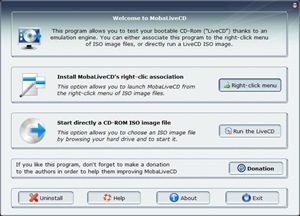Sometimes you might want to run a Linux live CD but don't want to reboot your computer because you are working on something else. One solution to this problem is to set up a virtual system and test the Live CD on it. But if you don't want to bother even with virtualization then MobaLiveCD is the tool for you.
MobaLiveCD is a freeware Windows only application that allows you to run Linux live CDs within Windows. Based on the QEMU emulator, MobaLiveCD does not require any installation. It's extremely light and you can run it from a thumb drive and simply point it to the ISO file. You can also install a small context menu addon that will enable you to run live CDs directly from within Windows Explorer by right clicking on an ISO file. It also allows you to create a virtual hard drive and save data from your live CD sessions.
MobaLiveCD does not require you to burn any CDs, but that is also a disadvantage of this program. It can run only ISO files, which means that if you have a live CD in a physical medium like CD or DVD, you can't run it with MobaLiveCD. Besides, it takes a hell lot of time to launch the OS, but that's expected since you are running an operating system inside another. Otherwise it's a nice little application to add to your collection.
[via Lifehacker]


Comments
Post a Comment